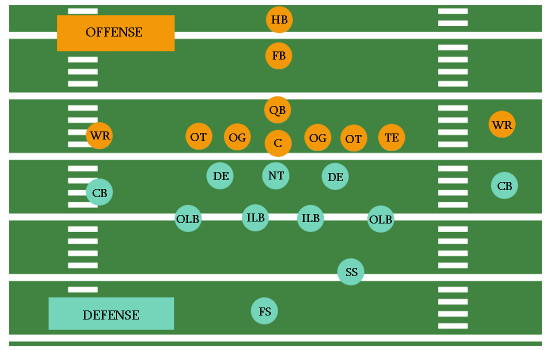AdBlock Detected!
Our website is made possible by displaying ads to our visitors. Please supporting us by whitelisting our website.

An illustration of football positions. The defense shown here is the 3-4 defense, meaning there are 3 defensive linemen and 4 linebackers. Another common defensive scheme is the 4-3 defense, where there are 4 defensive linemen and 3 linebackers.
Center (C): The offensive player who snaps the ball to start a play. This player also blocks for the runner on a running play and protects the quarterback on a passing play.
Offensive Guard (OG): An offensive lineman who lines up next to the center. An offensive guard's role is to block for the runner on running plays and protect the quarterback on passing plays.
Offensive Tackle (OT): An offensive lineman who lines up outside of the offensive guard. An offensive tackle's role is to block for the runner on running plays and protect the quarterback on passing plays.
Wide Receiver (WR): An offensive player who often lines up away from the line of scrimmage, and whose primary responsibility is to catch the football on a passing play. On running plays, a wide receiver often blocks for the runner.
Tight End (TE): A tight end often lines up at the end of the offensive line. On a running play, the tight end blocks for the runner. On a passing play, the tight end often runs out and becomes a pass target.
Quarterback (QB): The quarterback usually lines up behind center and receives the snap. On running plays, the quarterback hands off to the runner. On passing plays, the quarterback throws the pass to a receiver. The quarterback may also gain yards by running.
Fullback (FB): A fullback lines up between the quarterback and the halfback, and his primary role is to back for the halfback in a running play and to protect the quarterback on a passing play.
Halfback (HB): Also called the tailback. A halfback is usually smaller and quicker than the fullback, and is the primary ball carrier on running plays. On passing plays, a halfback often becomes a passing target.
Nose Tackle (NT): Also called a nose guard. A nose tackle is a defensive lineman who lines up directly across the opponent's center, commonly seen in a 3-4 defense. A nose tackle's primary role is to stop the run.
Defensive End (DE): A defensive lineman who lines up at the end of the defensive line. The primary role of the defensive end is to rush the quarterback.
Cornerback (CB): A defensive player whose primary responsibility is to defend against the pass.
Inside Linebacker (ILB): A defensive player who lines up behind the defensive line and has responsibility to stop plays that take place near the middle of the field.
Outside Linebacker (OLB): A linebacker who lines up behind the defensive line and has responsibility to stop plays that goes outside of the tackles. Outside linebackers sometimes rush the quarterback.
Strong Safety (SS): A defensive player who lines up on the strong side of the offense (the side where the tight end lines up), usually behind the linebackers. A strong safety supports the run defense on running plays and helps cornerbacks to defend the pass on passing plays.
Free Safety (FS): A defensive player who lines up behind the linebackers and the cornerbacks. A free safety should be a sure tackler as he is usually the last line of defense, and is expected to help the cornerback on deep passes.
Middle Linebacker (MLB): A linebacker who plays in the middle of the field behind the defensive line. Middle linebacker is a position in a 4-3 defense (not pictured). A middle linebacker is often the "quarterback" on defense, as he is the one who calls out defensive plays.
Defensive Tackle (DT): A defensive lineman who lines up on the inside of the defensive line in a 4-3 defense. The primary role of the defensive tackle is to stop the run.
Kicker (K): A position in football whose primary role is to kick field goals and extra points. Most kickers also handle kickoff duty.
Punter (P): The role of the punter is to punt the ball, usually on a fourth down, to keep the opposing team as far away as possible.
Holder (H): On a field goal attempt or an extra point attempt, the holder receives the snap from the center, and places the ball down on the ground for the kicker to kick the ball.
Kick Returner (KR): On a kickoff play, the receiving team usually has at least one kick returner, whose role is to catch the football and then gain as many yards as possible by returning the ball. The kick returner is usually the fastest player on the team.
Punt Returner (PR): On a punt play, the receiving team usually has at least one punt returner, whose role is to catch the football and then gain as many yards as possible by returning the ball. The punt returner is usually a fast player, and can be the same player as the kick returner.
Long Snapper (LS): In a kicking play from scrimmage (field goal, extra point, or punt), the offensive player who snaps the ball is call the long snapper, because the ball needs to travel for some distance (at least 5 yards) before reaching the holder or the punter.
Offensive Line: Center, Offensive Guards, Offensive Tackle, and sometimes the Tight End make up the offensive line.
Secondary: Cornerbacks and safeties together are called the secondary.
Running back: The fullback and halfback (tailback) together are called running backs.
Defensive Line: In a 3-4 defense, the defensive ends and the nose tackle make up the defensive line. In a 4-3 defense, the defensive ends and the defensive tackles make up the defensive line.
Our website is made possible by displaying ads to our visitors. Please supporting us by whitelisting our website.